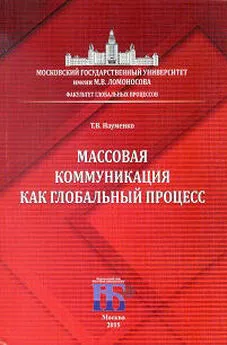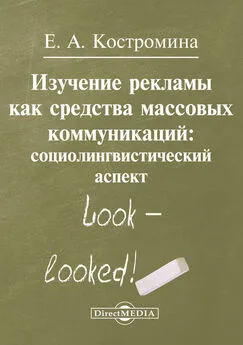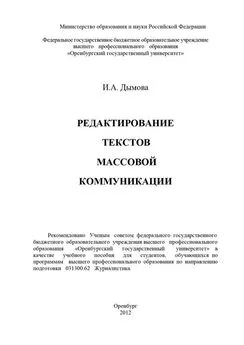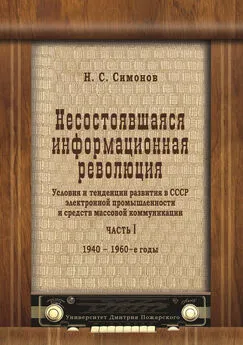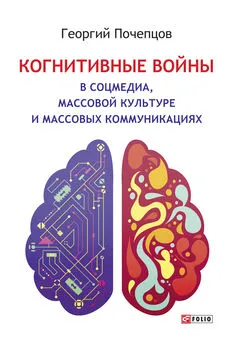Ричард Харрис - Психология массовых коммуникаций
- Название:Психология массовых коммуникаций
- Автор:
- Жанр:
- Издательство:2002
- Год:2002
- Город:Санкт-Петербург
- ISBN:5-93878-033-0
- Рейтинг:
- Избранное:Добавить в избранное
-
Отзывы:
-
Ваша оценка:
Ричард Харрис - Психология массовых коммуникаций краткое содержание
«Предупреждён – значит вооружён». Такой эпиграф мог бы открывать эту книгу. И не имеет значения, кто возьмёт её в руки. Специалист почерпнёт в ней новые приёмы и подходы к анализу стратегии и тактики СМИ. Любознательный обыватель научится обеспечивать собственную информационную безопасность.
Кроме того картина информационного ландшафта современного общества от предвыборного управления массовым сознанием до рекламы памперсов оказывается настолько захватывающей, что однажды начав читать эту книгу, вы уже не оставите её недочитанной.
Психология массовых коммуникаций - читать онлайн бесплатно полную версию (весь текст целиком)
Интервал:
Закладка:
Rich, F. (1997. December 26). Mental illness still needs a spokesman. Manhattan Mercury, p. A7.
Richards, J. I. (1990). Deceptive advertising. Hillsdale, NJ: Lawrence Eribaum Associates.
Riggs, M. (Director). (1992, June 15). Color adjustment. New York: Public Broadcasting Service.
Ritchie, D., Price, V. Roberts. D. F. (1987). Reading and television: A longitudinal investigation of the displacement hypothesis. Communication Research, 14, 292–315.
Roberts. D. R, Maccoby, N. (1985). Effects of mass communication. In: G. Lindzey E. Aronson (Eds.). Handbook of social psychology (3rd ed.). New York: Random House.
Robertson, T. S., Rossiter, J. R. (1974). Children and commercial persuasion: An attribution theory analysis. Journo/o/'Consumer/?escarc/;, /(!), 13–20.
Robertson, T. S., Ward. S., Gatignon, H., Klees, D. M. (1989). Advertising and children: A cross-cultural study. Communication Research. 16, 459–485.
Robinson, J. D. (1989). Mass media and the elderly: A uses and dependency interpretation. In: J. F. Nussbaum (Ed.). Life-span communication (p. 319–337). Hillsdale, NJ: Lawrence Eribaum Associates.
Robinson, J. P. (1990). Television's effects on families' uses of time. In: J. Bryant (Ed.). Television and the American family (p. 195–209). Hillsdale, NJ: Lawrence Eribaum Associates.
Robinson, J. R, Davis, D. K. (1990). Television news and the informed public: An information-processing approach. Journal of Communication, 40(3), 106–119.
Robinson, M. J., Shcehan, M. A, (1983). Over the wire and on TV: CBS and UPI in Campaign '80. New York: Sage.
Rogers, E. M., Dearing, J. W. (1988). Agenda-setting research: Where has it been, Where is it going? In J. A. Anderson (Ed.). Communication yearbook II (p. 555–594). Beverly Hills, CA: Sage.
Rogers, E. M., Dearing, J. W., Brcgman, D. (1993). The anatomy of agenda-setting research. Journal of Communication, 43(2), 68–84.
Rogers, E. M., Singhal, A. (1989). Estrategias de educacion entretenimiento [Strategics for educating through entertainment]. Chasqul, 31, 9–22.
Rogers, E. M., Singhal, A. (1990). The academic perspective. In: C. Atkin L. Wallack (Eds.). Mass communication and public health (p. 176–181). New-bury Park, CA: Sage.
Rojahn, K., Pettigrew, T. F. (1992). Memory for schema-relevant information: A meta-analytic resolution. British Journal of Social Psychology, 31, 81–109.
Rolandelli, D. R., Wright, J. C., Huston. A. C., Eakins, D. (1991). Children's auditory and visual processing of narrated and nonnarrated television programming. Journal of Experimental Child Psychology, 51, 90–122.
Romer, S. Jamieson, K. H., deCoteau, N. (1998). The treatment of persons of color in local television news. Communication Research, 25. 286–305.
Rosenberg, H. (1993, June II). TV gratuitously puts down another people. Manhattan Mercury, В 12.
Rosencrans, M. A., Hartup, W. W. (1967). Imitative influences of consistent and inconsistent response consequences to a model on aggressive behavior in children. Journal of Personality and Social Psychology, 7, 429–434.
Rosengren, K. E. (1992). The structural invariance of change: Comparative studies of media use (some results from a Swedish research program). In: J. G. Blumler, J. M. McLeod, К . Е . Rosengren (Eds.). Comparatively speaking: Communication and culture across space and time (p. 140–178). Newbury Park, CA: Sage.
Rosengren, K. E., Wenner, L. A., Palmgreen, P. (Eds.). (1985). Media gratifications research: Current perspectives. Newbury Park, CA: Sage.
Ross, J. (1992, August). The cola war's new front. World Press Review, p. 45.
Rotfeld, H. J. (1988). Fear appeals and persuasion: Assumptions and errors in advertising research. Curren/ fcsues one?/?esearc/!/n Adcerft's/ng. 11, 21–40.
Rothenberg, D. (1998, June 5). The sounds of global change: Different beats, new ideas. The Chronicle of Higher Education, p. B8.
Rothenbuhler, E. W. (1988). The living room celebration of the Olympic games…/owna/ of Communication, 38(4), 61–81.
Roy, A., Harwood, J. (1997). Underrcpresented, positively portrayed: Older adults in television commercials. Journal of Applied Communication Research, 25, 39–56.
Rubin, A. M. (1981). An examination of television viewing motivations. Communication Research, 8, 141–165.
Rubin, A. M. (1983). Television uses and gratifications: The interactions of viewing patterns and motivations. Journal of Broadcasting, 27, 37–51.
Rubin, A. M. (1984). Ritualized and instrumental television viewing. Journal of Communication, 34(3), 67–77.
Rubin, A. M. (1986). Uses, gratifications, and media effects research. In: J. Bryant D. Zillmann (Eds.). Perspectives on media effects (p. 281–301). Hillsdale, NJ: Lawrence Eribaum Associates.
Rubin, A. M. (1994). Media uses and effects: A uses-and-gratifications perspective. In: J. Bryant D. Zillmann (Eds.). Media effects: Advances in theory and research (p. 417–437). Hillsdale. NJ: Lawrence Eribaum Associates.
Rubin, A. M., Perse, E. M. (1987). Audience activity and television news gratifications. Communication Research, 14, 58–84.
Rubin, A. M., Perse, E. M. (1988). Audience activity and soap opera involvement. Human Communication Research, 14, 246–268.
Rubin, A. M., Perse, E. M., Powell, R. A. (1985). Loneliness, parasocial interaction, and local television news viewing. Human Communication Research, 12, 155–180.
Rubin, A. M., Perse. E. M., Taylor, D. S. (1988). A methodological examination of cultivation. Commun-fcorion/?eseorcn, /5, 107–134.
Rubin, A. M., Wmdahl, S. (1986). The uses and dependency model of mass communication. Critical Studies in Mass Communication, 3, 184–199.
Rubin, D. M., Cummings, C. (1989). Nuclear war and its consequences on television. Journal of Communication, 39(1), 39–58.
Rubin, R. В ., McHugh, M. P. (1987). Development of parasocial interaction relationships. Journal of Broadcasting Electronic Media. 31, 279–292.
Rumelhart, D. E. (1980). Schemata: Building blocks of cognition. In: R. J. Spiro, B. C. Bruce. W. F. Brewer (Eds.). Theoretical issues in reading comprehension (p. 33–58). Hillsdale, NJ: Lawrence Eribaum Associates.
Russo, J. E., Metcalf, B. L, Stevens, D. (1981). Identifying misleading advertising. Journal of Consumer Research, 8, 119–131.
Russo, V. (1981). The celluloid closet: Homosexuality in the movies. New York: Harper Row.
Sabo. D., Jansen, S. C. (1992). Images of men in sport media. In: S. Craig (Ed.). Men, masculinity, and the media (p. 169–184). Newbury Park, CA: Sage.
Sabo, D., Runfola, R. (Eds.). (1990). Jock: Sports and male identity. Englewood Cliffs, NJ: Prentice-Hall. Saegert. J. (1987). Why marketing should quit giving subliminal advertising the benefit of the doubt. Psychology Marketing, 4, 107–120.
Salomon, G. (1979). Interaction of media, cognition, and learning. San Francisco: Jossey-Bass.
Salomon, G. (1983). Television watching and mental effort: A social psychological view. In: J. Bryant D. Anderson (Eds.). Children's understanding of television (p. 181–198). New York: Academic Press.
Salomon, G. (1984). Television is "easy" and print is "tough": The differential investment of mental effort in learning as a function of perceptions and attributions. Journal of Educational Psychology, 76, 647–658.
Salomon, G. (1987). Television and reading: The roles of orientations and reciprocal relations. In: M. E. Manley-Casimir C. Luke (Eds.). Children and television (p. 15–33). New York: Praeger.
Sapolsky, B. S. (1984). Arousal, affect, and the aggression-moderating effect of erotica. In: N. M. Malamuth E. Donnerstein (Eds.). Pornography and sexual aggression (p. 85–113). Orlando, FL: Academic Press.
Sapolsky, B. S., Molitor, F. (1996). Content trends in contemporary horror films. In: J. B. Weaver and R. Tamborini (Eds.). Horror films: Current research on audience preferences and reactions (p. 33–48). Mahwah, NJ: Lawrence Eribaum Associates.
Schachter, S., Singer, J. E. (1962). Cognitive, social, and physiological determinants of emotional state. Psychological Review, 69, 379–399.
Schaefer, H. H., Colgan. A. H. (1977). The effect of pornography on penile tumesccnce as a function of reinforcement and novelty. Behavior Therapy. 8. 938–946.
Schank, R., Abelson, R. (1977). Scripts, plans, goals, and understanding. Hillsdale, NJ: Lawrence Eribaum Associates.
Schement. J. R., Gonzalez, J. N., Lum, P., Valencia, R. (1984). The international flow of television programs. Communication Research, II, 163–182.
Schlcuder, J., McCombs, M. E., Wanta, W. (1991). Inside the agenda setting process: How political advertising and TV news prime viewers to think about issues and candidates. In: F. Biocca (Ed.). Television and political advertising. Vol. I: Psychological processes (p. 265–309). Hillsdale, NJ: Lawrence Eribaum Associates.
Schlinger. M. J., Plummer, J. (1972). Advertising in black and white. Journal of Marketing Research, 9, 149–153.
Schneider, A. (1998, January 9). Advising Spielberg: A career studying the Amistad rebellion. The Chronicle of Higher Education, p. A12.
Schneider, J. A. (1987). Networks hold the line. In: A. A. Berger (Ed.). Television in society (p. 163–172). New Brunswick, NJ: Transaction Books.
Schneider, K. C.. Schneider, S. B. (1979). Trends in sex roles in television commercials. Journal of Marketing, 43(3), 79–84.
Schneider, S. L., Laurion. S. K. (1993). Do we know what we've learned from listening to the news? Memory Cognition, 21, 198–209.
Scholfield, J., Pavelchak, M. (1985). The Day After: The impact of a media event. American Psvchologist, 40, 542–548.
School of hard knocks. (1992, October 12). Time, 31–32.
Schooler, C., Chaffee, S. H., Flora, J. A., Roser. C. (1998). Health campaign channels: Tradeoffs among reach, specificity, and impact. Human Communication Research, 24, 410–432.
Schooler, C., Flora, J. A., Farquhar, J. W. (1993). Moving toward synergy: Media supplementation in the Stanford five-city project. Communication Research, 20, 587–610.
Schuman, H., Presser, S. (1981). Questions and answers in attitude surveys: Experiments on question form, wording, and context. New York: Academic Press. Schwartz, T. (1981). Afe: The second god. New York: Random House.
Seefeldt, C. (1977). Young and old together. Children Today, 6(1), 22.
Seggar. J. F., Hafen, J., Hannonen-Gladden. H. (1981). Television's portrayal of minorities and women in drama and comedy drama, 1971–1980. Journal of Broadcasting. 25(3), 277–288.
Seifart, H. (1984). Sport and economy: The commercialization of Olympic sport by the media. International Review for the Sociology of Sport, 19, 305–315.
Selnow, G. W (1990) Values in prime lime television. Journal of Communication. 40(2), 64–74.
Selnow, G. W. (1997). Electronic whistle-stops: The impact of the Internet on American politics. New York: Praeger.
Shaheen, J. G. (1984). The TV Arab. Bowling Green, OH: Bowling Green State University Popular Press.
Shaheen, J. G. (1992). The Arab stereotype: A villain without a human face. Extra!, 5(5), 26.
Shain, R.. Phillips, J. (1991). The stigma of mental illness: Labeling and stereotyping in the news. In: L. Wilkins P. Patterson (Eds.). Risky business: Communicating issues of science, risk, and public policy (p. 61–74). Westport, CT: Greenwood Press.
Shanteau, J. (1988). Consumer impression formation: The integration of visual and verbal information. In: S. Hecker D. W. Stewart (Eds.). Nonverbal communication in advertising (p. 43–57). Lexington, MA: Lexington.
Shanteau. J., Harris, R. J. (Eds.). (1990). Organ donation and transplantation: Psychological and behavioral factors. Washington, DC: American Psychological Association.
Читать дальшеИнтервал:
Закладка:

